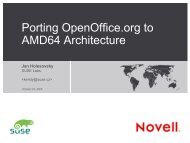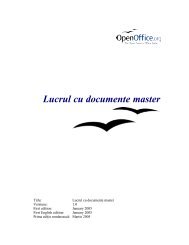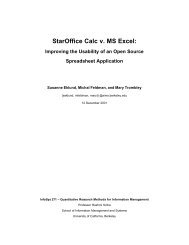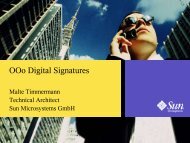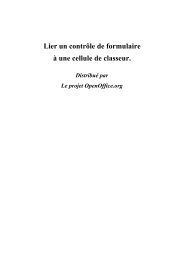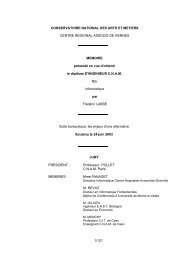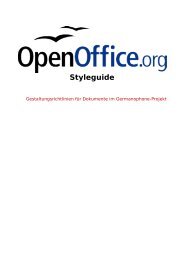Icon-Language, from Vision to Icon-Typing - OpenOffice.org
Icon-Language, from Vision to Icon-Typing - OpenOffice.org
Icon-Language, from Vision to Icon-Typing - OpenOffice.org
Create successful ePaper yourself
Turn your PDF publications into a flip-book with our unique Google optimized e-Paper software.
Jochen Gros<br />
jochen-gros@gmx.de<br />
<strong>Icon</strong>-<strong>Language</strong>, <strong>from</strong> <strong>Vision</strong> <strong>to</strong> <strong>Icon</strong>-<strong>Typing</strong><br />
Abstract: Old dreams of a "new picture-language" failed almost a century<br />
ago, but turned out as origin of the modern pic<strong>to</strong>gram. Today however these<br />
dreams might have a second chance: maybe as vision of a "new iconlanguage"<br />
including a renewed grammar and the design of icon-fonts.<br />
OpenType as well as Au<strong>to</strong>Correct fonts enable us, <strong>to</strong> type words and get<br />
icons – even animated icons as in <strong>OpenOffice</strong>. But what's the use of these<br />
fonts? One approach is already made in the field of language-learning.<br />
Another, introduced below, is going further on the way, but definitely beyond<br />
Smilies and Emoticons.<br />
Although these examples are in fact initial and makeshift steps <strong>from</strong> vision <strong>to</strong><br />
practice, they should demonstrate at least new methods of typing pictures in<br />
line with words.<br />
Key Words: <strong>Icon</strong>-<strong>Language</strong>, <strong>Icon</strong>-Font, <strong>Icon</strong>-<strong>Typing</strong>, OpenType,<br />
Au<strong>to</strong>Correct, Emoticons, Movicons, Smileyman<br />
smile+<br />
Almost a century ago Ot<strong>to</strong> Neurath, a philosopher, <strong>to</strong>gether with Gerd<br />
Arntz, a graphic designer, made fundamental efforts <strong>to</strong> develop something like<br />
a "new picture language" [1]. Both are still famous as fathers of the modern<br />
pic<strong>to</strong>gram, but their dream largely failed, not at least, because it was <strong>to</strong>o complicated<br />
<strong>to</strong> write "new hieroglyphics" with self-explaining shapes, much more<br />
detailed than Chinese characters.<br />
But now, we absolutely might have a second look at this meanwhile rather<br />
old dream of a "new picture language". Actually there are complex backgrounds:<br />
<strong>from</strong> age old conflicts in Christian and Muslim religions about the use<br />
of pictures instead of words, up <strong>to</strong> our present experience, how picture<br />
messages could gain speed and emotion.<br />
But these backgrounds are not the main issue here. Instead, I'll zoom in on<br />
the fact, that new technologies enable us <strong>to</strong> "write" pictures as easy as<br />
characters. In other words, I'll zoom in on the feasibility of a "new picture<br />
language".<br />
Being aware of all the pic<strong>to</strong>grams and icons around us, some people call<br />
this already a new international picture language. But without really nameable<br />
elements of a visual grammar, that's not even a pidgin or Creole language.<br />
– So, I'll first sketch out some basics of visual grammar,<br />
– then exemplify the design and programming of icon-fonts,<br />
– and finally demonstrate how icon-typing works in different applications,<br />
including, animated icons in <strong>OpenOffice</strong>.
Grammar in general provides rules how <strong>to</strong> built notions and sentences.<br />
Only in visual grammar these "rules" are very simple, almost self-evident.<br />
And they really pay off, expanding or even multiplying our pic<strong>to</strong>gram- and icon<br />
vocabulary [2].<br />
1. Backgrounding<br />
friend+<br />
give give+ get / take get+ friend friend+<br />
fatherfather+ mothermother+ parents parents+<br />
devil+<br />
2. Adjectives / Determinatives<br />
devil devil+ evil evil+<br />
shoplifting evil+buy+ killing evil+shoot+<br />
dance+<br />
3. Verbs<br />
go go+ meet meet+ dance dance+<br />
protect protect+ (protected protecte protection protecti)<br />
cow+<br />
4. Compound <strong>Icon</strong>s<br />
cook book cook+book+ library book+palace+ castle king+palace+<br />
shed cow+house+ bar bar+<br />
cop+<br />
5. Plural<br />
policeman cop+ cops cops+ police police+<br />
woods woods+ cattle cow+cow+bull+
freedom+<br />
Higher levels of visual abstraction are possible with epi<strong>to</strong>mes and<br />
metaphors. Epi<strong>to</strong>mes are typical examples, representing a category. But even,<br />
if we don't find a single and really striking example, there is an age old solution:<br />
the same as in Chinese, where "sun" and "moon" <strong>to</strong>gether are defining "light".<br />
So, multiple epi<strong>to</strong>mes are probably the most powerful method <strong>to</strong> visualize abstract<br />
notions – properly defined.<br />
Nevertheless there is also a great potential in visual metaphors. Starting<br />
with pic<strong>to</strong>grams of already incorporated figures like the Statue of Freedom.<br />
seduce+<br />
flower+<br />
6. Epi<strong>to</strong>mes<br />
art art+ art book art+book+ artist art+man+<br />
seduce seduce+<br />
community communit parish communitJesus+<br />
pay regard flower+<br />
office+<br />
I+<br />
We+<br />
7. Multiple Epi<strong>to</strong>mes<br />
party party+ disco disco+<br />
macho macho+<br />
office office+ travel agency travel+office+<br />
animal animal+<br />
8. <strong>Icon</strong>-Pidgin?<br />
I love you I+love+ you+ I alone I+alone+<br />
merry christmas merry+Christma<br />
we go <strong>to</strong> school We+ go+ <strong>to</strong>+ school+<br />
we are happy We+ are+ happy+
<strong>Icon</strong>-Fonts enable icon-typing. They enable us, <strong>to</strong> just write pictures with a<br />
keyboard. Visual grammar might be a first step <strong>from</strong> dream <strong>to</strong> vision, but<br />
icon-fonts are now providing the <strong>to</strong>ol, <strong>to</strong> go on <strong>from</strong> vision <strong>to</strong> practice.<br />
And there are two completely different ways <strong>to</strong> type words and display<br />
icons. First, the common TrueType or OpenType system, employed <strong>to</strong> create<br />
Times, Helvetica or Chinese fonts. Secondly, I'll propose the Au<strong>to</strong>Correct<br />
mode, as provided in Word and <strong>OpenOffice</strong>.<br />
OpenType is not yet explicitly prepared <strong>to</strong> create icon-fonts, but there is<br />
everything we need: the potential <strong>to</strong> embed thousands of icons in a single font<br />
and a simple feature for programming the relation between typed characters<br />
and displayed icons. Although this feature was only designed <strong>to</strong> allow "dependent<br />
ligatures" (a special form of typography), the code is open, <strong>to</strong> substitute<br />
for instance "w o m a n" by an icon named "woman".<br />
typing: woman<br />
displaying: woman+<br />
feature dlig {<br />
sub w o m a n by woman;<br />
sub 女 人 by woman;<br />
} dlig;<br />
At first however, <strong>to</strong> avoid unwillingly typing icons, we might add perhaps a<br />
marker like "+". So we are only replacing words such as woman, by typing<br />
"woman+".<br />
typing: woman+ displaying:woman+<br />
feature dlig {<br />
sub w o m a n plus by woman;<br />
sub 女 人 plus by woman;<br />
} dlig;<br />
Unfortunately, these OpenType fonts are <strong>to</strong> use only, if a text edi<strong>to</strong>r features<br />
"dependent ligatures" and – besides InDesign and QuarkExpress – this feature<br />
is at present only available in Apple "Pages" and "TextEdit", not yet in "Word" or<br />
"<strong>OpenOffice</strong>". In return they have better Au<strong>to</strong>Correct <strong>to</strong>ols.<br />
Au<strong>to</strong>Correct "fonts" are – so far – the result of a makeshift method, but<br />
they are easy <strong>to</strong> create: just feed the Au<strong>to</strong>Correct <strong>to</strong>ol with icons and type in<br />
alphabetic or Chinese characters in order <strong>to</strong> replace the words. To transfer<br />
these "fonts" <strong>from</strong> one PC <strong>to</strong> another, you only have <strong>to</strong> exchange the files, in<br />
which they are s<strong>to</strong>red.<br />
for <strong>OpenOffice</strong>: acor_en-US.dat<br />
typing: happy+ displaying:<br />
for Word: Normal.dotm<br />
In contrast <strong>to</strong> OpenType, Au<strong>to</strong>Correct fonts have certainly disadvantages,<br />
as the need of different fonts for each size and each text edi<strong>to</strong>r. But there are<br />
not only advantages, such as color and motion.<br />
Maybe most important: everyone can change the script; everyone has full<br />
control over all relations between the input of words and the output of icons;<br />
everyone is free <strong>to</strong> add new icons, even self designed ones. So, Au<strong>to</strong>Correct<br />
fonts might actually end up as kind of open-source for everyone.
angel+<br />
man+<br />
But who wants <strong>to</strong> make use of icon-fonts? In theory any vision of a<br />
"new picture-language" could gain substance with visual grammar and may<br />
get ready <strong>to</strong> use with icon-fonts. But in cool minds that's hardly more than a<br />
clear challenge for different applications, which still have <strong>to</strong> prove usability and<br />
attraction. So, two fairly sketched out concepts should give at least an idea,<br />
how <strong>to</strong> go on.<br />
Most advanced, the Japanese linguist Miyoko Yasui [3] is presenting a new<br />
concept at the upcoming conference for e-learning in Kyo<strong>to</strong>:<br />
"Advantages of icon-fonts in e-learning for language education/training" [4].<br />
Less specific in icon-linguistics, but hopefully moving closer <strong>to</strong> popular use,<br />
I have prepared four demo-versions of an icon-font with around 300 pictures,<br />
<strong>to</strong> use like "emoticons", but <strong>to</strong> display with names (and "+"). These fonts<br />
should not only demonstrate the OpenType and Au<strong>to</strong>Correct approach, but<br />
also illustrate different forms of icon-typography.<br />
Yet, unlike present emoticons, Smilies here got hands and feet, in order <strong>to</strong><br />
show gestures, body language and even sex, so <strong>to</strong> say as Smileyman and<br />
Smileywoman.<br />
All fonts are <strong>to</strong> download and free for personal use [5].<br />
OpenType:<br />
Emoticons.black.US.ttf<br />
Emoticons.line.US.ttf<br />
Au<strong>to</strong>Correct: Emoticons29.pix.US<br />
Emoticons29.pixmov.US<br />
(for Word: Normal.dotm)<br />
(for <strong>OpenOffice</strong>: acor_en-US.dat)<br />
hi+<br />
woman+<br />
happy+<br />
Emoticons.line.US.ttf. Since the "Emoticons.black" font is already displayed<br />
with visual grammar, "Emoticons.lineUS.ttf" may now illustrate possible<br />
looks in the tradition of Emoticons.<br />
hi+ / hello+ hi+ ni hao+ you+good+<br />
man+ and+ woman+ man+ and+ woman+<br />
angel+ angel+<br />
cow+ bull+cow+ bull+<br />
bullshit+ bullshit<br />
big+ big+ small+ / little+little+<br />
happy+<br />
lucky+<br />
welcome+<br />
devil+<br />
lucky+<br />
happy+<br />
welcome+<br />
devil+ hell+devil+devil+devil+
in love+<br />
biglove+<br />
Some icons are dispalyed as context dependent. So you may get even six different<br />
icons for "love+".<br />
I+ love+ you+I+love+ you+<br />
in love+<br />
inlove+<br />
declare love+ declare woman declare love+<br />
big love+<br />
make love+<br />
biglove+<br />
makelov<br />
womande<br />
sleep+ sleep+ sleep <strong>to</strong>gether+ sleep <strong>to</strong><br />
office+<br />
no+<br />
work+<br />
work+ work+ office+ office+<br />
cowboy+ cowboy+ cop+cop+ cook+cook+ boss+boss+ king+ king+<br />
eat+ food+ drink+drink+ woman+woman+<br />
party+<br />
party+<br />
I+ want+ you+ I+ want+ you+<br />
no+ sex+ no+ sex+<br />
pet+ stroke+ woman pet+ womanst<br />
petting+ petting+ woman petting+ womanpe<br />
safer sex+ protect+sex+<br />
exiting+ exited+ blowjob+ blowjob+ secret+secret+
Emoticons29.pix.US (for Word: Normal.dotm)<br />
Emoticons29.pixmov.US (for <strong>OpenOffice</strong>: acor_en-US.dat)<br />
These Au<strong>to</strong>Correct fonts have the same vocabulary and the same graphics, only<br />
the second one is moving in <strong>OpenOffice</strong>. Besides you may see the figures really<br />
moving on their website [6] – or just try <strong>to</strong> imagine the moves, which are frozen<br />
in this PDF.<br />
Please note: The correct spelling <strong>to</strong> display icons is coming <strong>to</strong>gether with the<br />
download of particular Au<strong>to</strong>Correct fonts.<br />
hi+ ni hao+ greetings+ woman greetings+<br />
respectfully+ sincerely+ (pay) regards+ best+<br />
man+ woman+ male+ couple+<br />
mother+ father+ child+ adult+<br />
boy+ girl+ brother+ sister+ girls+<br />
family+<br />
parents+<br />
call+ mobile+ woman mobile+ meet+<br />
go+ travel+ trekking+ hotel+<br />
send+ read+ news+ redme+<br />
good+ bad+ yeah+ ok+ no+/not+<br />
better+ glad+ super+ great+<br />
happy+ jump of joy+ merry+ / cheers+ laugh+<br />
sad+ man alone+ woman sad+ woman alone+<br />
girlfriend+<br />
boyfriend+
love+ woman love+ declare love+ woman declare love+<br />
big+ big love+ in love+ woman in love+<br />
pet+ woman pet+ pets+ hate+ woman hate+<br />
ecologist+ eco-care+ eco-protect+ trees+<br />
bio-food+<br />
tree+ nursery+<br />
anger+ woman anger+ pain+ blood+<br />
sick+ belly ache+ puke+/vomit+<br />
idot+ crazy+ back+/ass+ shit+ bullshit+<br />
dear+ woman dear+ welcome+<br />
embrace+ hug+/ hugs+ kiss+/ kisses+<br />
woman kiss+/ kisses+<br />
woman hug+/ woman hugs+<br />
eat+ drink+ woman+<br />
dance+ party+ disco+<br />
beer+ smoke+ smoke++<br />
pub+ restaurant+ bar+<br />
shop+<br />
smoke+ no+ room+
angel+ God+ woman angel+<br />
Jesus+ parish+ church+<br />
book+ bible+ Allah+ Koran<br />
aye+ honest+ belly+ delicious+ genitals+<br />
threat+ win+ winning team+<br />
big+ small+ fight+ play+<br />
devil+<br />
mafia+<br />
lying+ cheating+ shoplifting+<br />
hell+<br />
lazy+<br />
pho<strong>to</strong>+ shoot+ kill+ hunt+<br />
flower+ happy+ birthday+ woman flower+<br />
want+ woman want+ wish+ luck+<br />
office+ computer+ relax+ cop+ soldier+<br />
art+ artist+ architecture+<br />
school+ PhD+ university+ theory+<br />
car+ bus+ drive+ train+ TV+<br />
movie+ king+ queen+ money+ bank+
Eroticons are the climax of emoticons. So, if it really comes <strong>to</strong> emotion,<br />
you can't skip erotic icons (impossible anyway in private use). But again:<br />
most emotional are these pixels only as moving icons or movicons.<br />
seduce+<br />
striptease+<br />
man naked+ woman naked+ sex+ fuck+<br />
gay sex+ lesbian sex+ saver sex+<br />
man desire+<br />
woman desire+<br />
potent+ horny+ woman horny+<br />
make love+ woman make love+ man make love+<br />
lovers+ man pillow talk+ woman pillow talk+<br />
frustration+ man frust+ woman frust+<br />
Experimental design beyond emoticons may finally introduce<br />
metaphors.<br />
boss+<br />
supervisor+<br />
revolution+<br />
sexual revolution+<br />
justice+<br />
court+<br />
<strong>Icon</strong>-Pidgin elements, possible already with "Emoticon" fonts, may last<br />
not least announce next steps on the long, long way <strong>to</strong> a "icon-language".<br />
I+ want+ pizza+<br />
we+ go+ <strong>to</strong>+ New York+<br />
I+ have+ money+<br />
My+ boyfriend+ is+ ill+
Conclusion: Visual grammar and icon-fonts are certainly pre-conditions<br />
for any step by step development of different designs, which al<strong>to</strong>gether may<br />
point out <strong>to</strong> something like a "new icon-language".<br />
At first however, initial and makeshift solutions may open a wide range of<br />
experimental icon-fonts: <strong>to</strong> extend and sharpen graphic user interfaces, <strong>to</strong><br />
improve language-learning, or <strong>to</strong> upgrade – as sketched out here – the common<br />
use of emotional icons or emoticons. In principle, it's all part of the question,<br />
how <strong>to</strong> express ourselves side by side in words and visual concepts – at<br />
hand in any text edi<strong>to</strong>r.<br />
From this point of view <strong>OpenOffice</strong> has two major advantages: animated<br />
icons and moreover, the open source philosophy.<br />
But it could also provide advanced OpenType features and even better<br />
solutions for creating and installing Au<strong>to</strong>Correct fonts.<br />
References:<br />
[1] Neurath, Ot<strong>to</strong>: (19. Oct, 2008).<br />
Arntz, Gerd: (19. Oct, 2008)<br />
[2] For the full grammar, see:<br />
Gros, Jochen: <strong>Icon</strong>-<strong>Typing</strong> (German / English) BoD, 2006.<br />
Gros, Jochen: <strong>Icon</strong>-Sprache, Kapitel 7, in: Rayan Abdullah & Roger Hübner,<br />
Pik<strong>to</strong>gramme und <strong>Icon</strong>s, Verlag Hermann Schmidts Mainz, 2006<br />
[English translation, Jochen Gros: A <strong>Language</strong> of <strong>Icon</strong>s, Chapter 7 in:<br />
Rayan Abdullah & Roger Hübner: Pic<strong>to</strong>grams <strong>Icon</strong>s & Signs",<br />
Thames & Hudson, New York, London, 2007]<br />
[Japanese translation published by BNN, Inc., 2006].<br />
[3] Yasui, Miyoko: <br />
Japanese picture dictionary:<br />
, (5 Oct, 2008).<br />
Yasui, Miyoko: Picture dictionary of English:<br />
(5 Oct, 2008).<br />
[4] Yasui, Miyoko and Gros, Jochen: "Advantages of icon-fonts in e-learning<br />
for language education/training". The paper is <strong>to</strong> download under<br />
.<br />
[5] <strong>Icon</strong>-fonts <strong>to</strong> download:<br />
<br />
[6] <br />
<br />
<br />
Biographical Information:<br />
Jochen Gros, Prof. em.<br />
1974-2004 Design-Theory at the University of Fine Arts<br />
(Hochschule für Gestaltung) Offenbach, Germany.<br />



